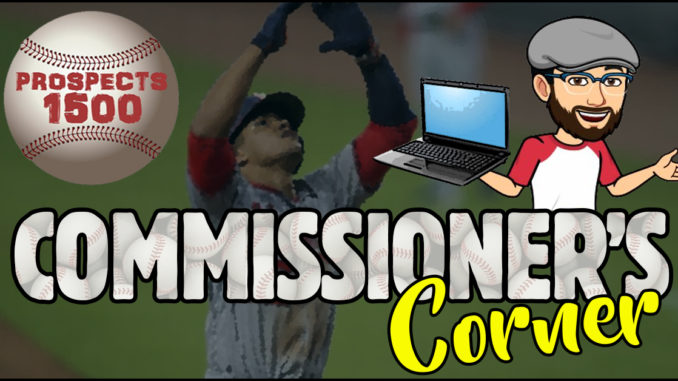
Commissioner’s Corner is back for Part 2 of “Launching a Dynasty League.” In Part 1 we talked about some of the tough questions prospective commissioners should ask themselves before starting a new league. In Part 2, let’s move on to creating your league setup and constitution.
One of my favorite things about dynasty baseball is the nearly unlimited amount of variations that are possible from league to league. For that reason, I’m not going to get into the specifics of each facet of a league ruleset. Instead, I’m going to list the elements that are key to a great dynasty league and talk about how to implement them.
Create Balanced Active Rosters
Deciding how many teams are going to be in the league and how many spots there will be on the rosters are two parts of the same exercise. The goal should be to create balance across the league and a nearly depleted waiver/free agent pool. You don’t want replacement talent to be readily available for free. In a dynasty league, the results should be based on team building and not waiver skills. In my experience, a balanced roster is one that has enough roster spots to allow a GM to develop injury replacement depth, but not so many spots that they can safely stream players from your waiver wire or free agent pool. Take into account your active player positions and how one might effectively build a bench to support those positions when deciding how big your rosters should be.
One way to gauge the right number of teams and roster spots is to compare it to your past experience in other leagues. If you’re looking at a 16 team league, think about the last 16 team league you were in. How big were the rosters and how easy was it to grab talent off of the waiver wire? If you’re thinking about starting a league, you probably have an opinion about how good or bad that experience was and you can adjust your settings accordingly.
Foster a Robust Trade Market
In my experience, leagues that have lots of trading tend to retain good GMs and live longer in general. Nearly every aspect of your setup will affect the trade market. Here are just a few ways you can enhance the conditions for trading in your league setup.
First, institute limits on how long a player can be retained by a team. Whether you accomplish this by simply setting a limited number of years or using a more complex system with salaries, limiting how long a player can be retained creates additional motivation for trades. Player retention is almost always an element in real-life trades and there’s no reason it can’t be part of your league’s reality.
Second, if you use a trade approval process, err on the side of passing trades through. Make it very hard to veto a trade so that it only happens in the rarest of circumstances where clear collusion or tanking is present. Opinions are like, well, you know…everyone’s got one. There will occasionally be trades that a few managers loudly disagree with, but player value is subjective and if you’ve recruited good GMs they should be allowed to do their thing. At a minimum, don’t create a review system that includes only select GMs as that will only create division.
Finally, if your league has a yearly prospect draft, allow GMs to trade those picks. Teams in win-now mode can then use those assets to add depth or replace injured players, while building teams can stockpile future talent.
Create Deep Prospect Rosters
Having deep prospect rosters does a couple of things for your league. First, it requires time and effort to research prospects and actually know what you’re doing when rostering them. Making prospecting a big part of your setup will require time and effort from your GMs, which will weed out the ones that don’t belong and allow you to keep the league healthy. Secondly, it gives teams a multitude of strategies and timelines for competing for a championship. I don’t think I’ve ever seen a fantasy league with legitimate parity. There will always be teams that are trending down, but prospects can give those teams hope and real reason to stick with it over the long haul. The deeper you go in terms of prospect spots per team, the greater this effect becomes.
Build in an Active Offseason
Baseball season is 50% of the year. There are no games and no scoring the other 50% of the year. Keeping GMs engaged during the offseason is critical for the health of the league, but overdoing it can be just as harmful as not doing it. Here are a few ways to ensure that your league will stick together through the offseason.
First, build offseason activities into the league setup. For instance, if you are setting player contract limits, the offseason is a great time to move expiring players into a free agent pool and either do a draft or have an auction to determine new ownership. It’s also a great time for your yearly prospect draft. Before you begin any of these activities, make sure your GM list is confirmed for the following season. I like to have my GMs pay their buy-in for next season before we do anything, that way if there is any turnover I can deal with that before teams start making moves.
Second, DO take a break. The temptation might be to start offseason activities immediately after the season. Even in complex leagues, there won’t be 6 months of work to do, so take a break for at least a month and enjoy the real-life playoffs. Your GMs are going to want to disconnect from the grind of fantasy baseball and if you start offseason activities too early you’ll be done in December and have nothing to do until Opening Day.
Third, once you do restart league activities, make sure you spread them out and complete them in a logical order. I like to open up trading for a month or so before starting free agent bidding so that teams can look at the player pool and make some preparatory moves. I also like to do the prospect draft last so that it is ongoing during spring training and provides a good kick start to the regular season. Map out the different aspects of your offseason on the calendar and share that with your GMs well before the regular season ends. The more everyone is on the same page before the break, the easier your job will be getting it restarted.
Utilize a Messaging Platform
Creating an atmosphere where friendships develop between GMs is HUGE for the success of your league. My leagues use Slack, but there are a number of solutions out there for creating a community for your league. Not only will these platforms enhance your league’s trade market, but they will also foster the development of relationships that transcend the league. In my leagues, you will often find chatter during big events like the College Football Playoffs or the NBA Finals. A relationship built on messaging in a dynasty league is how I got my spot here at Prospects1500 and I’ve made dozens of great friends along the way. If you take nothing else away from this article, don’t skip this step. It’s so worth it.
MAILBAG:
“What’s your advice on what to do with an absent owner and his or her team? The team is pretty bad and nobody is willing to put the time in to rebuild or revamp it so it’s been languishing in last place with no hope.”
– T.B. (Philadelphia, PA)
Great question! Unfortunately, this is an all too common occurance in dynasty leagues. It’s also one of the circumstances that really puts pressure on the Commissioner’s discretion.
In my experience, if the dynasty league is properly set up there shouldn’t be such a thing as a team beyond repair. Bringing in a new GM may be a daunting task, but there are GMs out there that like a challenge and will be willing to take on that challenge. If you can avoid giving any special advantages to the new GM and find someone that will do the work to rebuild it by the rules in place, that’s the best outcome. There are a number of incentives that you can provide to GMs if the team is in truly dire shape like a reduced or eliminated buy-in for a set number of seasons or additional prospect draft picks. If you have some version of free agency in the offseason, you could allow the new GM to take one or more players off of the top before starting your process. If you’re going to give some advantages to the new GM, make sure they are clearly communicated to the rest of the league and that you have wide buy-in from the group.
It’s also important to look at the circumstances that led to a team falling into such disrepair. Ask yourself if there are any league settings that contributed and if you need to propose any changes. If you find that the GM was allowed to neglect the team for a significant length of time, make adjustments to your league maintenance routine to ensure that you notice teams in decline more quickly.
Whether you are a commissioner or GM, I want to hear from you about dynasty league management and I’ll answer your questions in future editions of Commissioner’s Corner. Send your questions to me below in the Comments, on Twitter @ChappyisClutch or to my actual mailbag ChappyisClutch@gmail.com.





Good article Jared. I have run a dynasty league for going on 15 years, however I can sometimes find it difficult to find quality owners when people leave the league. Where do you find is the best way to find quality owners?
Sometimes existing owners will vouch for someone, but they don’t quite meet our league expectations which can complicate things.
Thanks, Bill. Sorry for taking so long to respond. You pose a great question and one that every dynasty commissioner will face repeatedly over the life of a league.
If you don’t mind, I’ll save my long form answer for a future edition of the mailbag. For now I will just say that the best managers in my leagues all come from other leagues that I have competed in as a manager and from their referrals. That said, I’ve also had some good luck with the Fantrax and NBCEdge (formerly RotoWorld) forums. I’m not afraid to bring a total stranger to the league, because occassionally they turn out to be great managers. I just wouldn’t build a whole league that way.
Thanks again for the great question.